Prone on a Ball
PurposeTo develop ability to bear weight on arms.
Instructions
- Place child on stomach, lying on a ball as pictured. Be sure to hold legs apart with feet and knees turned out.
- Slowly roll the child forward.
- You may place a toy in front of the ball to encourage the child to reach down.
- Child will place both hands on floor.
- Child will reach for toy with one hand.

Reaching While Prone Over Roll
PurposeTo aid child in increasing strength in neck and back muscles: to enable child to bear weight on one arm while reaching with the other.
Instructions
- Place child on stomach, lying over a roll.
- Hold child's legs apart with knees rolled out and straight.
- Encourage child to reach out for toys with one hand while shifting weight to opposite side.
Child will reach out while bearing weight on one arm. Don't forget to switch arms.
Special Instructions
Air splint would be helpful with this activity.
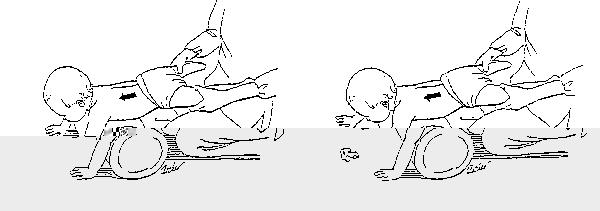
Forward Acceleration Over Roll
PurposeTo increase child's ability to bear weight on arms for forward protective extension.
Instructions
- Place child on stomach over a roll, with hands on floor. Hold child's legs apart with knees straight and rolled outward.
- Roll child forward so that most of child's body weight is on arms.
Child will be able to support own body weight on hands with elbows straight, hands open, and head erect.
Undesired Response
Back, neck, or arms will become stiff; hands will fist, or elbows and head will bend.
Special Instructions
Support right arm as needed (another good one with air splint).
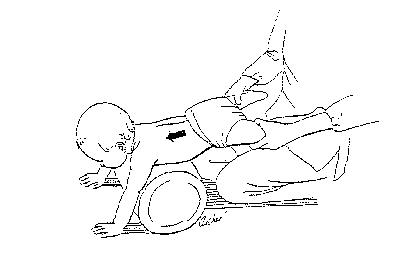
Hands to Midline
PurposeTo assist child in bringing hands together for play.
Instructions
- Sit in a comfortable position with your knees bent.
- Place child on back, lying with hips bent and feet on your chest.
- Bring child's arms forward so that hands are together and are at a level that the child can easily see. This is also a good position for you to talk to your child.
Child will be able to play with hands at midline, will become more aware of own hands, and will actively begin to bring hands together.
Undesired Response
Child will push backwards with shoulders or head.
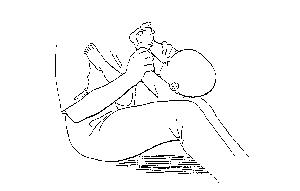
Hands To Mouth
PurposeTo assist child in the normal hand-to-mouth activity for sensory development.
Instrcutions
This activity can be done sitting (as pictured), or with child lying on side. The child
should be relaxed. It is helpful to bend the hips and to bring the shoulders forward.
Slowly bring hand to mouth - do not force.
Desired Response
With or without your assistance, child will be able to bring hand to mouth.
Undesired Response
Child will push back with shoulders or will react unpleasantly to having hand at the mouth.
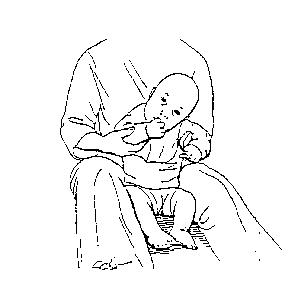
Hand to Foot
PurposeTo promote awareness of the hands and feet.
Instructions
This activity can be done sitting (as pictured), or with child lying on the back or side.
The child should be relaxed. Hold one arm at the elbow and one leg at the knee. Bring
hand and foot together.
Desired Response
Child will actively move. Child will become more aware of these areas of the body.
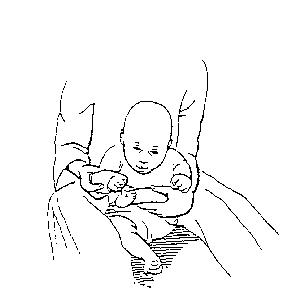
Prone Weight-Bearing on Arms with Approximation
PurposeTo enable child to bear weight on arms and strengthen neck and back muscles.
Instructions
- Sit on the floor.
- Place child on stomach, lying over your legs with child's hands on floor.
- Place your hands over the child's shoulders.
- Firmly push downward on child's shoulders and release. Repeat several times.
Child will be able to support weight on hands with elbows straight, hands open, and head erect.
Special Instructions
Be aware of right arm position and hand position. Keep arm at right angle to body, elbow
straight (with your assistance) and palm open.
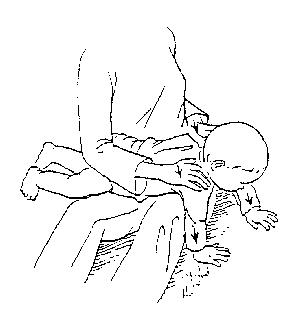
Tilting Sideways on Roll
PurposeTo encourage protective reactions of arms.
Instructions
- Place child on stomach, lying parallel to the length of the roll
- Support the hips or lower trunk as needed.
- Slowly tilt the child and roll sideways.
The child will support self with hand at the end of the movement.
Undesired Response
Arms will bend rather than straighten.
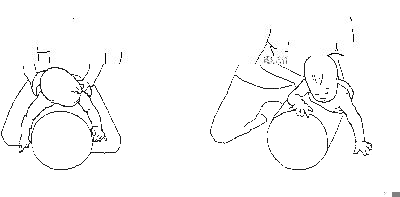
Shoulder Elevation
PurposeTo encourage shoulder elevation and outward rotation.
Instructions
- Place child on stomach on your legs
- As you play with the child, slowly shift your leg out to the side, so that your leg moves under the child's chest to under the arms. This will gradually allow more shoulder elevation by the child
- Support the child's shoulder forward and help child turn thumbs up.
Shoulder elevation will occur with outward rotation while head is up.
Undesired Response
- Shoulders will pull down and back.
- Thumbs will turn down.
- Elbows will bend.
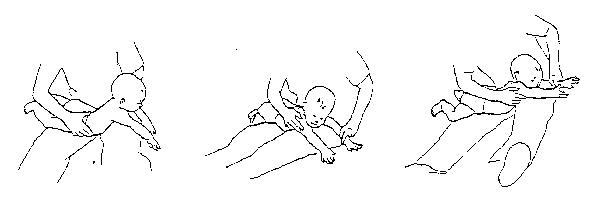
Hand Sweep
PurposeTo encourage child to get hand flat on a solid surface.
Instructions
- Place child in a sitting position. Sit behind the child.
- Hold the child's arm as pictured in Figure 10.
- Lift child's arm and brush fingers on the floor in a forward motion.
- Place child's hand with palm flat on the floor.
- Apply pressure downward through the arm. Be sure to keep the elbow straight.
- Repeat several times if necessary to get fingers open and straight.
Child will take some weight on hand with fingers and elbow remaining straight.
Undesired Response
Hand will remain fisted or elbow will bend.
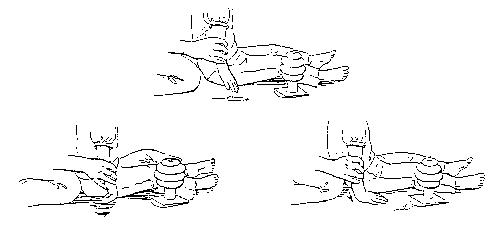
Ball Rolling
PurposeTo encourage child to straighten arms.
Instructions
- Place child in a propped sitting position.
- Place your hands over the child's hands and assist child in rolling the ball forward. As the child improves at this activity, you may decrease your assistance.
Desired Response
When child pushes ball, arms will straighten.
Undesired Response
Child's arms will turn in.
Special Instructions
This exercise is good for sensory input, awareness of both arms and weight bearing.
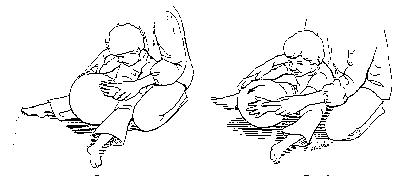
Weight-Bearing on Extended Arms
PurposeTo develop the ability to stabilize with upper arm for weight-bearing and other activities.
Instructions
- Place child on stomach in front of you.
- Spread child's legs apart on either side of your waist with the knees straight.
- Assist child at shoulders to lift self up onto arms.
- If child's trunk sags, gently rub child's stomach so muscles will straighten trunk.
- If arms do not remain straight, gently tap back of arm just above the elbows so muscles will straighten elbows.
Desired Response
Child will maintain weight on straight arms with straight trunk.
Undesired Response
The trunk will sag or arms will bend and not maintain child's weight.
Special Instructions
Just another good position for weight-bearing. Support arm into elbow extension.
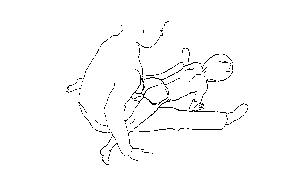
Weight Shift and Protective Extension to Side
PurposeTo encourage weight shifting while sitting with protective extension to the side.
Instructions
- Place child in sitting position in front of you.
- Place one hand on the child's shoulder and the other hand on the child's opposite elbow.
- Gently push the child at the shoulder.
- Assist child in straightening arm and placing hand on the floor.
- Intermittently press arm down and release. Repeat several times. Do not lift child's hand off floor.
Desired Response
Child will bear some weight on arm with elbow and fingers straight. Gradually less assistance should be required to perform this activity.
Undesired Response
Elbow will bend or hand will remain fisted.
Special Instructions
Good position for play. Place toy on right side, support right arm and have child use left arm for play.
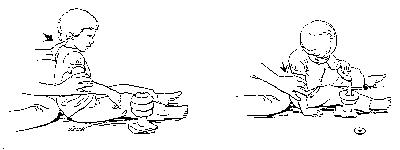
Click back to the Membrane Domain
